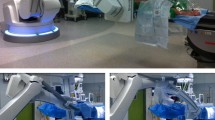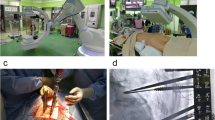Abstract
To date, biplanar imaging (2D) has been the method of choice for pedicle screw (PS) positioning and verified for the anteroposterior view and (spinal midline) M-line method. In recent years, the use of intraoperative three-dimensional (3D) imaging has become available with the Gertzbein–Robbins system (GRS) to assess PS breach and positioning confirmation. The aim is to determine if 2D imaging is sufficient to assess PS position in comparison to advanced 3D imaging.
Retrospective review of prospectively collected data from 204 consecutive adult patients who underwent posterior thoracic and lumbar instrumented fusion for degenerative spinal surgery by a single surgeon (2019–2022).
Of the 204 patients, 187 (91.6%) had intraoperative images available for analysis. A total of 1044 PS implants were used; 922 (88.3%) were robotically placed. Postoperative CT scans were verified with M-line/GRS findings. Among 103 patients (50.5%) with a total of 362 screws, (34.7%) had postoperative CT, intraoperative 3D scan, and intraoperative 2D scan for analysis. Postoperative CT findings were consistent with all GRS findings, validating that 3D imaging was accurate. Screws (1%) were falsely verified by the M-line as 3D imaging confirmed false negative or positive findings.
In our series, intraoperative 3D scan was as accurate as postoperative CT scan in assessing PS breach. A significant number of PS may be falsely read as accurate on 2D imaging, that is in fact inaccurate when assessed on 3D imaging. An intraoperative post-instrumentation 3D scan may be preferable to prevent postoperative recognition of a falsely verified screw on biplanar imaging.





Similar content being viewed by others
Data availability
The data that support the findings of this study are available from the corresponding author, DRL, upon reasonable request.
References
Woo EJ, DiCuccio MN (2018) Clinically significant pedicle screw malposition is an underestimated cause of radiculopathy. Spine J 18:1166–1171
Maejima R, Takeuchi M, Wakao N et al (2019) Reliability of an intraoperative radiographic anteroposterior view of the spinal midline for detection of pedicle screws breaching the medial pedicle wall in the thoracic, lumbar, and sacral spine. World Neurosurg 125:e257–e261
Castro WH, Halm H, Jerosch J et al (1996) Accuracy of pedicle screw placement in lumbar vertebrae. Spine (Phila Pa 1976) 21:1320–4
Gelalis ID, Paschos NK, Pakos EE et al (2012) Accuracy of pedicle screw placement: a systematic review of prospective in vivo studies comparing free hand, fluoroscopy guidance and navigation techniques. Eur Spine J 21:247–255
Slomczykowski M, Roberto M, Schneeberger P (1999) Radiation dose for pedicle screw insertion. Fluoroscopic method versus computer-assisted surgery. Spine 24:975–982. https://doi.org/10.1097/00007632-199905150-00009
Laine T, Schlenzka D, Mäkitalo K, Tallroth K, Nolte LP, Visarius H (1997) Improved accuracy of pedicle screw insertion with computer-assisted surgery. A prospective clinical trial of 30 patients. Spine 22:1254–1258. https://doi.org/10.1097/00007632-199706010-00018
Mirza SK, Wiggins GC, Kuntz Ch IV, York JE, Bellabarba C, Knonodi MA, Chapman JR, Shaffrey CI (2003) Accuracy of thoracic vertebral body screw placement using standard fluoroscopy, fluoroscopic image guidance, and computed tomographic image guidance. Spine 28:402–413
Elmi-Terander A, Burström G, Nachabe R, Skulason H, Pedersen K, Fagerlund M, Ståhl F, Charalampidis A, Söderman M, Holmin S, Babic D, Jenniskens I, Edström E, Gerdhem P (2019) Pedicle screw placement using augmented reality surgical navigation with intraoperative 3D imaging: a first in-human prospective cohort study. Spine (Phila Pa 1976) 44(7):517–525. https://doi.org/10.1097/BRS.0000000000002876.PMID:30234816;PMCID:PMC6426349
Lee YC, Lee R (2020) Image-guided pedicle screws using intraoperative cone-beam CT and navigation. A cost-effectiveness study J Clin Neurosci 72:68–71
Avrumova F, Morse KW, Heath M, Widmann RF, Lebl DR (2021) Evaluation of K-wireless robotic and navigation assisted pedicle screw placement in adult degenerative spinal surgery: learning curve and technical notes. J Spine Surg 7(2):141–154. https://doi.org/10.21037/jss-20-687. (Erratum. In: J Spine Surg. 2022 Sep; 8(3):405. PMID: 34296026; PMCID: PMC8261565)
Scheufler KM, Franke J, Eckardt A, Dohmen H (2011) Accuracy of image-guided pedicle screw placement using intraoperative computed tomography-based navigation with automated referencing. Part II: thoracolumbar spine. Neurosurgery 69:1307–1316. https://doi.org/10.1227/NEU.0b013e31822ba190. (PMID: 21734616)
Tormenti MJ, Kostov DB, Gardner PA et al (2010) Intraoperative computed tomography image-guided navigation for posterior thoracolumbar spinal instrumentation in spinal deformity surgery. Neurosurg Focus 28:E11
Costa F, Cardia A, Ortolina A, Fabio G, Zerbi A, Fornari M (2011) Spinal navigation: standard preoperative versus intraoperative computed tomography data set acquisition for computer-guidance system: radiological and clinical study in 100 consecutive patients. Spine (Phila Pa 1976) 36:2094–2098. https://doi.org/10.1097/BRS.0b013e318201129d. (PMID: 21304425)
Cui G, Wang Y, Kao TH, Zhang Y, Liu Z, Liu B, Li J, Zhang X, Zhu S, Lu N, Mao K, Wang Z, Zhang X, Yuan X, Dong T, Xiao S (2012) Application of intraoperative computed tomography with or without navigation system in surgical correction of spinal deformity: a preliminary result of 59 consecutive human cases. Spine (Phila Pa 1976) 37:891–900. https://doi.org/10.1097/BRS.0b013e31823aff81. (PMID: 22024897)
Zausinger S, Scheder B, Uhl E, Heigl T, Morhard D, Tonn JC (2009) Intraoperative computed tomography with integrated navigation system in spinal stabilizations. Spine (Phila Pa 1976) 34:2919–2926. https://doi.org/10.1097/BRS.0b013e3181b77b19. (PMID: 20010400)
Chang CJ, Lin GL, Tse A, Chu HY, Tseng CS (2015) Registration of 2D C-arm and 3D CT images for a C-arm image-assisted navigation system for spinal surgery. Appl Bionics Biomech 2015:478062. https://doi.org/10.1155/2015/478062. (Epub 2015 May 28. PMID: 27018859; PMCID: PMC4745431)
Narain AS, Hijji FY, Yom KH, Kudaravalli KT, Haws BE, Singh K (2017) Radiation exposure and reduction in the operating room: Perspectives and future directions in spine surgery. World J Orthop 8(7):524–530. https://doi.org/10.5312/wjo.v8.i7.524. (PMID:28808622;PMCID:PMC5534400)
Librianto D, Saleh I, Fachrisal, Utami WS, Hutami WD (2021) Breach rate analysis of pedicle screw instrumentation using free-hand technique in the surgical correction of adolescent idiopathic scoliosis. J Orthop Case Rep 11(1):38–44. https://doi.org/10.13107/jocr.2021.v11.i01.1956. (PMID: 34141640; PMCID: PMC8046465)
Aoude A, Ghadakzadeh S, Alhamzah H et al (2018) Postoperative assessment of pedicle screws and management of breaches: a survey among Canadian spine surgeons and a new scoring system. Asian Spine J 12:37–46
Odate S, Fujibayashi S, Otsuki B et al (2022) Reoperation for misplaced pedicle screws: a multicenter retrospective study. Spine (Phila Pa 1976) 47:1525–31
Shin MH, Ryu KS, Park CK (2012) Accuracy and safety in pedicle screw placement in the thoracic and lumbar spines : comparison study between conventional C-arm fluoroscopy and navigation coupled with O-arm(R) guided methods. J Korean Neurosurg Soc 52:204–209
Adogwa O, Parker SL, Shau D et al (2015) Cost per quality-adjusted life year gained of revision fusion for lumbar pseudoarthrosis: defining the value of surgery. J Spinal Disord Tech 28:101–105
Sankey EW, Mehta VA, Wang TY et al (2020) The medicolegal impact of misplaced pedicle and lateral mass screws on spine surgery in the United States. Neurosurg Focus 49:E20
Funding
The authors declare that no funds, grants, or other support were received during the preparation of this manuscript.
Author information
Authors and Affiliations
Contributions
GG, FA, and DRL contributed to the study conception and design. Material preparation, data collection, and analysis were performed by GG and FA. The first draft of the manuscript was written by GG and FA and all authors commented on previous versions of the manuscript. GG and FA prepared all figures and tables. All authors read and approved the final manuscript. Conceptualization: FA, JAC, DRL. Data Curation: GG, FA, PKP, GKP. Formal Analysis: GG, FA, JAC. Investigation: All authors. Methodology: DRL, FA, JAC. Project Administration: FA. Resources: DRL, FA. Validation: All authors. Writing—original draft: GG, FA, DRL. Writing—review and editing: All authors.
Corresponding author
Ethics declarations
Conflict of interest
GG, FA, PKP, and GKP do not have any conflicts of interest to disclose. JAC reports being a Governing Board Member for the American College of Rheumatology (ACR), the International Society of Osteoarthritis Imaging, and the Radiology Society of North America. JAC reports to be a consultant for AstraZeneca, Covera Health, Eli Lilly & Company, Globus Medical, Inc., Pfizer, and Regeneron Pharmaceuticals, Inc. DRL reports royalties from Stryker, royalties from NuVasive, ownership interest from Woven Orthopedic Technologies, ownership interest from Viseon, Inc, ownership interest from Vestia Ventures MiRus Investment LLC, ownership interest from ISPH II, LLC, ownership interest from HS2, LLC, ownership interest from Remedy Logic, on the advisory board for Remedy Logic, on the advisory board for Choice Spine, a consultant for Choice Spine, a consultant for Depuy Synthes and a consultant for Viseon, Inc outside the submitted work.
Ethical approval
Ethical approval was obtained from the Institutional Review Board at the Hospital for Special Surgery (IRB#2019-1402). The study was conducted in accordance with the Declaration of Helsinki. Approval was granted by the Ethics Committee at the Hospital for Special Surgery (2019-1402).
Consent to participate
The participants did not need to give informed consent in addition to routine informed consent procedures.
Additional information
Publisher's Note
Springer Nature remains neutral with regard to jurisdictional claims in published maps and institutional affiliations.
Rights and permissions
Springer Nature or its licensor (e.g. a society or other partner) holds exclusive rights to this article under a publishing agreement with the author(s) or other rightsholder(s); author self-archiving of the accepted manuscript version of this article is solely governed by the terms of such publishing agreement and applicable law.
About this article
Cite this article
Gorgy, G., Avrumova, F., Paschal, P.K. et al. Assessing intraoperative pedicle screw placement accuracy using biplanar radiographs compared to three-dimensional imaging. J Robotic Surg 18, 68 (2024). https://doi.org/10.1007/s11701-023-01760-2
Received:
Accepted:
Published:
DOI: https://doi.org/10.1007/s11701-023-01760-2




